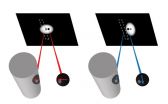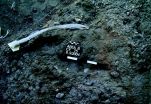(Press-News.org) Berkeley -- Scientists at the University of California, Berkeley, have identified a new molecular pathway critical to aging, and confirmed that the process can be manipulated to help make old blood like new again.
The researchers found that blood stem cells' ability to repair damage caused by inappropriate protein folding in the mitochondria, a cell's energy station, is critical to their survival and regenerative capacity.
The discovery, to be published in the March 20 issue of the journal Science, has implications for research on reversing the signs of aging, a process thought to be caused by increased cellular stress and damage.
"Ultimately, a cell dies when it can't deal well with stress," said study senior author Danica Chen, an assistant professor in the Department of Nutritional Sciences and Toxicology. "We found that by slowing down the activity of mitochondria in the blood stem cells of mice, we were able to enhance their capacity to handle stress and rejuvenate old blood. This confirms the significance of this pathway in the aging process."
Mitochondria host a multitude of proteins that need to be folded properly to function correctly. When the folding goes awry, the mitochondrial unfolded-protein response, or UPRmt, kicks in to boost the production of specific proteins to fix or remove the misfolded protein.
Chen's lab stumbled upon the importance of UPRmt in blood stem cell aging while studying a class of proteins known as sirtuins, which are increasingly recognized as stress-resistance regulators.
The researchers noticed that levels of one particular sirtuin, SIRT7, increase as a way to help cells cope with stress from misfolded proteins in the mitochondria. Notably, SIRT7 levels decline with age.
There has been little research on the UPRmt pathway, but studies in roundworms suggest that its activity increases when there is a burst of mitochondrial growth.
Chen noted that adult stem cells are normally in a quiescent, standby mode with little mitochondrial activity. They are activated only when needed to replenish tissue, at which time mitochondrial activity increases and stem cells proliferate and differentiate. When protein-folding problems occur, however, this fast growth could lead to more harm.
"We isolated blood stem cells from aged mice and found that when we increased the levels of SIRT7, we were able to reduce mitochondrial protein-folding stress," said Chen. "We then transplanted the blood stem cells back into mice, and SIRT7 improved the blood stem cells' regenerative capacity."
The new study found that blood stem cells deficient in SIRT7 proliferate more. This faster growth is due to increased protein production and increased activity of the mitochondria, and slowing things down appears to be a critical step in giving cells time to recover from stress, the researchers found. Chen likened this to an auto accident or stalled car jamming traffic on a freeway.
"You can deal with this congestion by removing all the cars that are blocked, but you can also stop more cars from getting onto the freeway," she said. "When there's a mitochondrial protein-folding problem, there is a traffic jam in the mitochondria. If you prevent more proteins from being created and added to the mitochondria, you are helping to reduce the jam."
Until this study, it was unclear which stress signals regulated the transition of stem cells to and from the quiescent mode, and how that related to tissue regeneration during aging.
"Identifying the role of this mitochondrial pathway in blood stem cells gives us a new target for controlling the aging process," said Chen.
INFORMATION:
UC Berkeley co-lead authors of the study are postdoctoral researcher Mary Mohrin and graduate students Jiyung Shin, Yufei Liu and Katharine Brown.
The National Institutes of Health, Ellison Medical Foundation, Glenn Foundation, National Science Foundation and Siebel Stem Cell Institute helped support this research.
Without better local management, the world's most iconic ecosystems are at risk of collapse under climate change, say researchers in a study published in the journal Science.
The international team of researchers say protecting places of global environmental importance such as the Great Barrier Reef and the Amazon rainforest from climate change requires reducing the other pressures they face, for example overfishing, fertilizer pollution or land clearing.
The researchers warn that localised issues, such as declining water quality from nutrient pollution or deforestation, ...
The 2014 chemistry Nobel Prize recognized important microscopy research that enabled greatly improved spatial resolution. This innovation, resulting in nanometer resolution, was made possible by making the source (the emitter) of the illumination quite small and by moving it quite close to the object being imaged. One problem with this approach is that in such proximity, the emitter and object can interact with each other, blurring the resulting image. Now, a new JQI study has shown how to sharpen nanoscale microscopy (nanoscopy) even more by better locating the exact ...
Sifting through the center of the Milky Way galaxy, astronomers have made the first direct observations - using an infrared telescope aboard a modified Boeing 747 - of cosmic building-block dust resulting from an ancient supernova.
"Dust itself is very important because it's the stuff that forms stars and planets, like the sun and Earth, respectively, so to know where it comes from is an important question," said lead author Ryan Lau, Cornell postdoctoral associate for astronomy, in research published March 19 in Science Express. "Our work strongly reinforces the theory ...
Researchers from Banner Alzheimer's Institute (BAI) have developed a new brain image analysis method to better track the progression of beta-amyloid plaque deposition, a characteristic brain abnormality in Alzheimer's disease, according to a study published in the March issue of the Journal of Nuclear Medicine. Investigators also believe this new approach may make it easier to evaluate investigational anti-amyloid treatments in clinical trials.
During the last decade, researchers have been using positron emission topography (PET) to assess amyloid plaque deposition in ...
A psychology study from The University of Texas at Austin sheds new light on today's standards of beauty, attributing modern men's preferences for women with a curvy backside to prehistoric influences.
The study, published online in Evolution and Human Behavior, investigated men's mate preference for women with a "theoretically optimal angle of lumbar curvature," a 45.5 degree curve from back to buttocks allowing ancestral women to better support, provide for, and carry out multiple pregnancies.
"What's fascinating about this research is that it is yet another scientific ...
WASHINGTON, March 19, 2015 -- It's a simple claim made on thousands of personal care products for adults and kids: hypoallergenic. But what does that actually mean? Turns out, it can mean whatever manufacturers want it to mean, and that can leave you feeling itchy. Speaking of Chemistry is back this week with Sophia Cai explaining why "hypoallergenic" isn't really a thing. Check it out here: http://youtu.be/lXh8bnqMOZs.
Speaking of Chemistry is a production of Chemical & Engineering News, a weekly magazine of the American Chemical Society. The program features fascinating, ...
The Canadian research community on high-temperature superconductivity continues to lead this exciting scientific field with groundbreaking results coming hot on the heels of big theoretical questions.
The latest breakthrough, which will be published March 20 in Science, answers a key question on the microscopic electronic structure of cuprate superconductors, the most celebrated material family in our quest for true room-temperature superconductivity.
This result is the product of a longstanding close collaboration between the University of British Columbia Quantum ...
Some 2.5 million years ago, early humans survived on a paltry diet of plants. As the human brain expanded, however, it required more substantial nourishment - namely fat and meat - to sustain it. This drove prehistoric man, who lacked the requisite claws and sharp teeth of carnivores, to develop the skills and tools necessary to hunt animals and butcher fat and meat from large carcasses.
Among elephant remains some 500,000 years old at a Lower Paleolithic site in Revadim, Israel, Prof. Ran Barkai and his graduate students Natasha Solodenko and Andrea Zupanchich of Tel ...
DENVER, March 23, 2015 -- Since HIV emerged in the '80s, drug "cocktails" transformed the deadly disease into a manageable one. But the virus is adept at developing resistance to drugs, and treatment regimens require tweaking that can be costly. Now scientists at the 249th National Meeting & Exposition of the American Chemical Society (ACS) are announcing new progress toward affordable drugs that could potentially thwart the virus's ability to resist them.
ACS, the world's largest scientific society, is holding the meeting here through Thursday. It features nearly 11,000 ...
Washington, D.C.--To combat global climate change caused by greenhouse gases, alternative energy sources and other types of environmental recourse actions are needed. There are a variety of proposals that involve using vertical ocean pipes to move seawater to the surface from the depths in order to reap different potential climate benefits. A new study from a group of Carnegie scientists determines that these types of pipes could actually increase global warming quite drastically. It is published in Environmental Research Letters.
One proposed strategy--called Ocean ...



